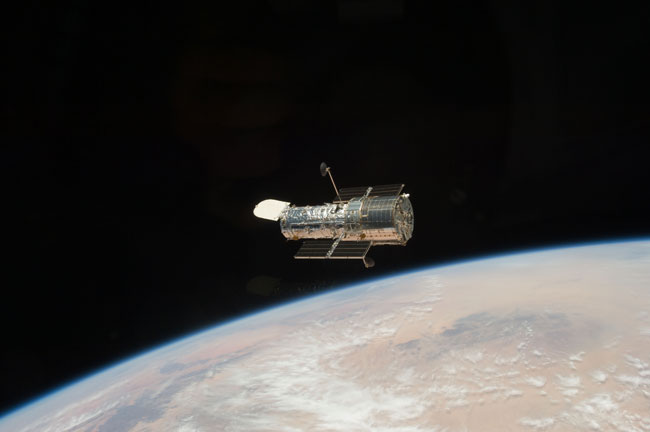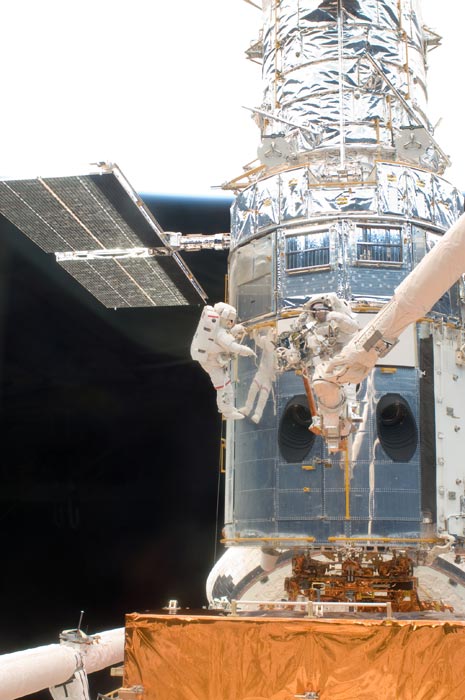Hubble Space Telescope Could Last Until 2018, NASA Says

LONG BEACH, Calif. — NASA's 23-year-old Hubble Space Telescope is still going strong, and agency officials said Tuesday (Jan. 8) they plan to operate it until its instruments finally give out, potentially for another six years at least.
After its final overhaul in 2009, the Hubble telescope was expected to last until at least 2015. Now, NASA officials say they are committed to keeping the iconic space observatory going as long as possible.
"Hubble will continue to operate as long as its systems are running well," Paul Hertz, director of the Astrophysics Division in NASA's Science Mission Directorate, said here at the 221st meeting of the American Astronomical Society. Hubble, like other long-running NASA missions such as the Spitzer Space Telescope, will be reviewed every two years to ensure that the mission is continuing to provide science worth the cost of operating it, Hertz added.
In fact, Hubble supporters hope it will continue to run even after its successor, the James Webb Space Telescope (JWST), is launched — an event planned for 2018.
"We are not planning to arbitrarily end the operation of Hubble when JWST is launched," Hertz said during a NASA Town Hall Meeting at the AAS conference. "It may be great if we get at least one year of overlap between JWST and Hubble." [Building the James Webb Space Telescope (Photos)]

The Hubble Space Telescope was launched in April 1990, and has since been upgraded five times by astronauts in orbit. Its last space shuttle servicing mission in May 2009 left the scope with two new instruments, including a wide-field camera and a high-precision spectrograph to spread out light into its constituent wavelengths. The space telescope is named after the late astronomer Edwin Hubble (1889-1953), who proved that the universe is expanding.
"It's working better than ever, 23 years in," Dan Coe, an astronomer working with Hubble at the Space Telescope Science Institute in Baltimore, Md., told SPACE.com. "We're still pushing the frontier."
Get the Space.com Newsletter
Breaking space news, the latest updates on rocket launches, skywatching events and more!
Coe agreed that overlap time with both Hubble and James Webb operating simultaneously would be ideal. Such a plan would allow the observatories to work on complementary projects and provide crosschecks between the two telescopes' measurements.
How long Hubble can run also depends on NASA's budget, which, like funding for all federal agencies, is uncertain given the economic challenges in the United States.
"It all comes down to money," Coe said.
Funding the development of the James Webb Space Telescope is currently taking up almost half of NASA's total budget of $1.3 billion for astrophysics in 2013, Hertz said. The observatory has an estimated price tag of $8.7 billion, and will cost about $628 million in 2013 alone. In contrast, Hubble will cost about $98 million in 2013.
You can follow SPACE.com assistant managing editor Clara Moskowitz on Twitter @ClaraMoskowitz. Follow SPACE.com on Twitter @Spacedotcom. We're also on Facebook & Google+.
Join our Space Forums to keep talking space on the latest missions, night sky and more! And if you have a news tip, correction or comment, let us know at: community@space.com.

Clara Moskowitz is a science and space writer who joined the Space.com team in 2008 and served as Assistant Managing Editor from 2011 to 2013. Clara has a bachelor's degree in astronomy and physics from Wesleyan University, and a graduate certificate in science writing from the University of California, Santa Cruz. She covers everything from astronomy to human spaceflight and once aced a NASTAR suborbital spaceflight training program for space missions. Clara is currently Associate Editor of Scientific American. To see her latest project is, follow Clara on Twitter.









